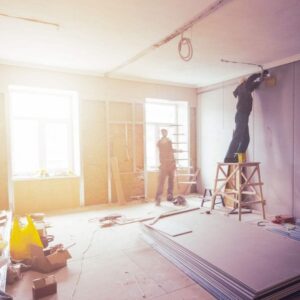What Are The Signs To Replace Your Old Plaster Wall
Is your home starting to show signs of aging? One of the key areas to look out for is your plaster walls. Over time, plaster walls can deteriorate and lose their charm, affecting the overall appearance and structural integrity of your home.
To help you identify when it’s time to consider a replacement, we’ve compiled a list of 7 signs that indicate it’s time to say goodbye to your old plaster wall.

1. Cracks and Flaking
A telltale sign that your plaster wall is in need of replacement is the appearance of cracks and flaking. These imperfections can start small but will gradually worsen over time, causing an unsightly appearance. If left unaddressed, cracks and flaking can lead to more significant issues like water leakage and structural instability.
2. Frequent Repairs
If you find yourself calling in a plasterer for repairs a couple of times a year, it’s a clear sign that your plaster wall has seen better days. Frequent repairs not only become a financial burden but also indicate that the underlying issue may be beyond mere patching. Investing in a new plaster wall with quality materials will save you from the hassle of continuous repairs.
Are you looking to transform your entire walls with a fresh plastering process? Trust QLD Int Lining, a professional plastering service provider, for expertly handling any repair job, whether it’s interior or exterior walls.

3. Sagging or Bubbling
If you notice that your plaster wall is sagging or bubbling, it is likely due to water damage. Moisture infiltration can weaken the plaster’s bond with the wall, causing it to sag or bubble. This not only looks unappealing but can also be hazardous as the weakened wall may eventually collapse. A new plaster wall with proper waterproofing will ensure a durable and safe solution.
4. Visible Discolouration
Stains and discolouration on your plaster walls can be signs of mould growth or water seepage. These issues not only affect the aesthetics but also pose health risks to you and your family. A new plaster wall, coupled with the right techniques and materials, can prevent mould and water-related problems, creating a healthier living environment.
5. Uneven Surface
As plaster walls age, they may develop an uneven surface due to settling or wear and tear. An uneven surface affects the appearance and makes it challenging to achieve a quality finish when painting or decorating. A fresh plaster wall ensures a smooth canvas for your desired decorative plaster or paint finish.
6. Crumbling and Powdery Texture
If you notice that your plaster wall has a crumbling or powdery texture, it’s a clear indication of its deterioration. This happens over time as the plaster’s binding agents break down, resulting in a weak and unstable surface. A new solid plastering application will provide a more robust and long-lasting solution.
7. Outdated Appearance
Finally, an outdated plaster wall can bring down the overall aesthetics of your home. If you’re looking to revamp your interior and give it a fresh look, investing in a new plaster wall is a great place to start. You can transform your space into a modern and stylish environment with various decorative plaster options.
What Are The Reasons For Cracks Forming On a Plastered Wall?
 The reasons for cracks on a plastered wall are like puzzle pieces. Each reason contributes to the bigger picture of why the wall is cracking. Cracks on plastered walls are a common problem for homeowners. Several factors contribute to the formation of these cracks, including poor initial preparation, dryness in the wall, excessive vibration, temperature variations, and structural movements.
The reasons for cracks on a plastered wall are like puzzle pieces. Each reason contributes to the bigger picture of why the wall is cracking. Cracks on plastered walls are a common problem for homeowners. Several factors contribute to the formation of these cracks, including poor initial preparation, dryness in the wall, excessive vibration, temperature variations, and structural movements.
- Proper preparation of the surface is crucial to ensure proper adhesion and prevent cracking of plastered walls. Dryness in the wall occurs when the wall is not properly hydrated before plastering, leading to drying and shrinkage that results in cracks.
- Excessive vibration from construction work, nearby traffic, or heavy footsteps can also cause plaster to crack.
- Various factors, such as vibration, temperature fluctuations, and structural movements, can also contribute to cracks in plastered walls over time.
- Applying the appropriate plaster thickness and using strong materials like mesh or fibreglass can help prevent cracks and keep the surface clean and free of dirt and debris.
By following these tips, cracks on plastered walls can be prevented, and the wall will remain clean and aesthetically pleasing for years.
QLD Professional Plasterers At Your Service
Now that you are aware of the signs that indicate the need for a new plaster wall, it’s essential to hire professional plasterers for the job. Attempting DIY plastering may lead to more costly mistakes and unsatisfactory results. For quality workmanship, friendly service, and a wide range of plastering services, trust QLD Interior Linings – your reliable plastering team in Queensland.
We take pride in delivering high-quality plastering services for both residential and commercial projects. Our skilled plasterers use only the best materials, ensuring a quality finish that will stand the test of time. Whether you need plaster repair, ceiling repairs, or a new plaster wall, we’ve got you covered.
Don’t let your old plaster wall hold back the beauty and value of your home. Contact us today for affordable plastering solutions and enjoy a fresh, modern interior with a solid plastering application. Say goodbye to your old plaster woes and welcome a new, improved living space!
Remember, when it comes to plastering, trust the experts – call QLD Interior Linings now!
Some FAQs
Q: How can I tell if my plaster wall needs to be replaced?
A: Look for signs such as cracks, bulges, water damage, or crumbling plaster.
Q: What causes plaster walls to deteriorate?
A: Common causes include age, moisture, shifting foundations, and poor maintenance.
Q: Can I repair small cracks in my plaster wall?
A: Yes, small cracks can often be repaired with a patching compound or joint compound. However, it’s best to find a plastering contractor for a professional finish for complicated cracks.
Q: When should I consider replacing my plaster wall instead of repairing it?
A: If there are extensive cracks, severe water damage, or if the plaster is crumbling, it may be more cost-effective to replace the wall.
Q: How long does plaster typically last?
A: Plaster walls can last for many decades if properly maintained, but eventually, they may need to be replaced due to age or damage.
Q: What are the benefits of replacing a plaster wall?
A: Replacing a plaster wall can provide a smoother, more durable surface, better insulation, and an opportunity to update the appearance of the room.
Q: Can I replace my plaster wall with drywall?
A: Yes, drywall is a commonly used alternative to plaster and can be easier to install and repair.
Q: Should I hire a professional to replace my plaster wall?
A: To ensure a high-quality result, hiring a reliable plastering company or contractor with experience in wall replacement and plastering processes is often recommended.
Q: How much does it cost to replace a plaster wall?
A: The pricing may fluctuate based on factors like wall size, damage extent, and region, but typically, the cost of plastering entire walls is higher compared to a plaster wall repair job. Trust our experienced plasterers for reliable estimates and quality workmanship.
Q: How long does it take to replace a plaster wall?
A: The project duration will be influenced by different factors, such as wall size and installation complexity, and usually, it takes several days to finish the plastering process. For a detailed understanding, talk to your potential plasterers.
Q: What Is The Best Type Of Paint To Put On Newly Plastered Walls?
A: The newly plastered walls are like a blank canvas ready for a pop of colour! Now, when it comes to choosing the best type of paint, you’ll want to make sure you go for a top-notch option.
Water-based acrylic paint is a real ripper for newly plastered walls. It’s durable, easy to apply, and dries up faster.
Plus, it’s low on fumes, so you won’t be coughing up a storm while you’re painting. Or maybe it’s time to bring in a skilled painter to work their magic. They’ll consider the texture of your walls, the surface condition, and even the climate down under.
Whether it’s water-based or oil-based paint, they’ll have the lowdown on what’ll give your walls that perfect finish, making them look like real work of art.
Q: Is It Possible To Plaster Directly Onto a Brick Wall?
A: Plastering directly onto a brick wall is possible, but there are some important factors to consider before doing so.
First, the brick wall should be clean and free of any loose debris or mortar. If the wall is particularly rough or uneven, applying a scratch coat or base coat of plaster may be necessary to create a smoother surface for the final coat.
Additionally, it is important to use the right type of plaster for the job, as some types may not adhere well to brick.
For best results, consulting with a professional or experienced plasterer is recommended to ensure that the job is done correctly and safely.
The Article 7 Signs To Replace Your Old Plaster Wall First Appeared ON
: https://ad4sc.com
Comments are closed